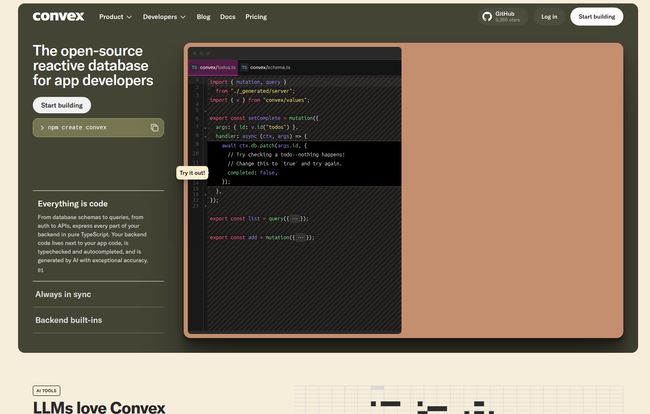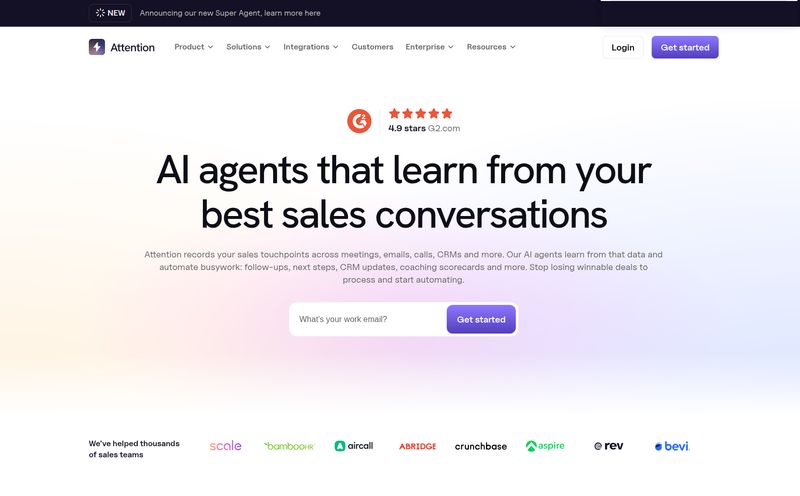For years, as a developer who mostly lives and breathes on the frontend, the backend has always felt like this necessary, slightly annoying chore. It’s like being a chef who loves crafting the perfect dish but first has to go out and forge the pots and pans from raw iron. Setting up a database, writing API endpoints, managing state synchronization, figuring out authentication… it's a mountain of work before you can even get to the fun stuff.
We’ve had solutions, of course. Firebase has been the 800-pound gorilla in the Backend-as-a-Service (BaaS) room for a decade. And it's fine! It's powerful. But I've always felt like I was duct-taping it onto my modern TypeScript and React projects. The type safety would just... fall off a cliff the moment I made an API call. So when I started hearing whispers about Convex, I was skeptical but intrigued. Another BaaS? Yawn. But this one claimed to be different. It was built from the ground up for TypeScript.
My curiosity piqued, I decided to take a look. And folks, I think this might be the one.
So, What is Convex, Really?
On the surface, Convex bills itself as a “full-stack TypeScript platform with a realtime database.” That’s a mouthful. Let me translate. Imagine if your database, your server functions, and your client-side data fetching all spoke the same language—TypeScript. Not just spoke it, but were fluent in it, sharing types and ensuring you never again have to `console.log(response)` to remember if it’s `user.id` or `user._id`.
It’s a backend that feels less like a separate, distant server and more like a natural extension of your application code. It handles the database, the server logic, file storage, and even scheduled tasks (cron jobs) for you. It’s the digital plumbing, but instead of rusty pipes, it's all clean, modern, and self-documenting. A pretty big promise.
The Features That Genuinely Got Me Excited
Every platform has a laundry list of features. But a few of Convex's capabilities really stood out to me as solving actual, day-to-day developer frustrations.
Full-Stack TypeScript is a Dream Come True
This is the headline feature for me. With Convex, you define your database schema in a TypeScript file. Your queries and your server-side functions (they call them 'mutations' and 'queries') are also just TypeScript functions. The result? Complete, end-to-end type safety. When you call a query from your React component, you know exactly what shape the data will be in. Your IDE knows. Your linter knows. It catches errors at compile time, not runtime. This alone saves hours of debugging silly API mismatch errors. It’s the kind of developer experience I wish I had on every project.

Visit Convex
Realtime by Default Feels Like Magic
I remember a project a few years back where I spent an entire weekend trying to get WebSockets to play nice with my authentication layer just to show a live activity feed. It was a nightmare. Convex makes this trivial. It’s realtime by default. When one user makes a change to the database, the data is automatically pushed to every other connected client. You don't set up subscriptions or manage WebSocket connections. You just write a query, and the UI component that uses it… updates. Automatically.
This isn't just for chat apps. It makes any collaborative or dynamic application feel incredibly responsive and alive. It changes how you think about building UIs, moving from a “fetch-then-render” model to a “subscribe-and-react” one. It’s a subtle but powerful shift.
It Handles the Boring Stuff For You
Let's be honest, nobody enjoys building authentication from scratch for the tenth time. Convex comes with backend built-ins that are just… there. Authentication, file storage, and even cron jobs for scheduled tasks are part of the package. Recently they've even added first-class support for AI workflows, letting you integrate LLMs directly into your backend functions. This lets you focus on your app's unique features, not the boilerplate that every single web app needs.
Convex versus The Big Guy, Firebase
You can't talk about a new BaaS without comparing it to Firebase. It's the benchmark. So, how does Convex stack up?
I've used Firebase on a number of projects, and while it's incredibly robust, it feels like a product of a different era—an era before TypeScript became the standard for serious frontend development. The Firestore API is powerful but not type-safe. You're constantly asserting types or working with `any`. Convex, being TypeScript-native, just runs circles around it in this department.
Another huge point for Convex is that it’s open source. This is a massive deal. One of the biggest fears with any BaaS is vendor lock-in. What happens if they change their pricing or shut down a feature you rely on? With Convex, you have the option to pack up and self-host. That’s a safety net that closed-source platforms like Firebase simply can't offer.
Now, to be fair, Firebase has a decade of maturity, a larger community, and a broader suite of integrated products (like Cloud Functions, Analytics, etc.). Convex is still the new kid on the block. Finding a Stack Overflow answer might be a bit harder. But for a pure, modern, reactive application development experience, I think Convex presents a seriously compelling argument.
Breaking Down The Convex Pricing
Money talks. A great platform is useless if you can't afford it. Convex's pricing model seems pretty straightforward and fair, especially for teams just starting out.
| Plan | Cost | Best For |
|---|---|---|
| Starter | Free | Hobbyists, prototypes, and getting your feet wet. |
| Professional | $25 / developer / month | Teams with growing projects that need to scale. |
The free tier is generous enough to build a real, functioning prototype without pulling out your credit card. The Professional plan's per-develoepr pricing is an interesting model, but at $25, it’s very reasonable for the productivity boost it provides a professional team. Like most BaaS platforms, costs will also scale with your usage (database reads/writes, function invocations), which is standard practice. It seems like a fair deal for the power you're getting.
The Honest Downsides
No tool is perfect, and it wouldn't be a real review if I didn't point out the potential bumps in the road. Convex is still relatively new. This means its ecosystem is smaller than that of a giant like Firebase. The community is growing, but you're more of a pioneer than a settler.
There's also a bit of a learning curve. While it's all TypeScript, you do have to learn the 'Convex way' of defining data, writing queries, and structuring your backend logic. It’s not steep, but it's not zero. If you're coming from a traditional REST or GraphQL background, you'll need a moment to adjust your thinking.
So, Should You Give Convex a Shot?
After spending some quality time with it, my answer is a resounding yes. Especially if you're a TypeScript developer. The sheer joy of having end-to-end type safety and a realtime backend that just works is hard to overstate. It feels like the kind of platform that was designed with modern web development in mind from day one.
Is it a complete Firebase killer? Maybe not for every use case just yet. Enterprises with deep roots in the Google Cloud ecosystem might hesitate. But for new startups, indie developers, and anyone building a reactive, collaborative app in TypeScript, Convex isn’t just an alternative; in my opinion, it's a better choice. It's a bet on a more modern, more integrated, and frankly, more enjoyable way to build full-stack applications.
Frequently Asked Questions about Convex
- Is Convex just another database?
- Not at all. While it has a realtime database at its core, Convex is a full backend platform. It includes serverless functions, authentication, file storage, and more, all integrated into a single TypeScript environment.
- Can I use Convex if I'm not using TypeScript?
- You technically can use it with plain JavaScript, but you'd be missing out on its main superpower: full-stack type safety. It's really designed to be used with TypeScript for the best experience.
- How does Convex compare to Supabase?
- That's a great question. Supabase is another excellent open-source Firebase alternative, but its approach is different. Supabase gives you a full-fledged Postgres database and builds tools around it. It's great if you love SQL. Convex is more of a document-style database and is built to be TypeScript-native from the ground up, offering a more integrated, 'magical' feel for state management.
- Is Convex actually free to start?
- Yes, it has a generous free 'Starter' tier that's perfect for building personal projects, prototypes, and getting a feel for the platform before you need to commit financially.
- Can I really self-host Convex?
- Yes. Since the backend is open-source, you have the freedom to host it on your own infrastructure, which is a significant advantage for long-term projects and avoiding vendor lock-in.



